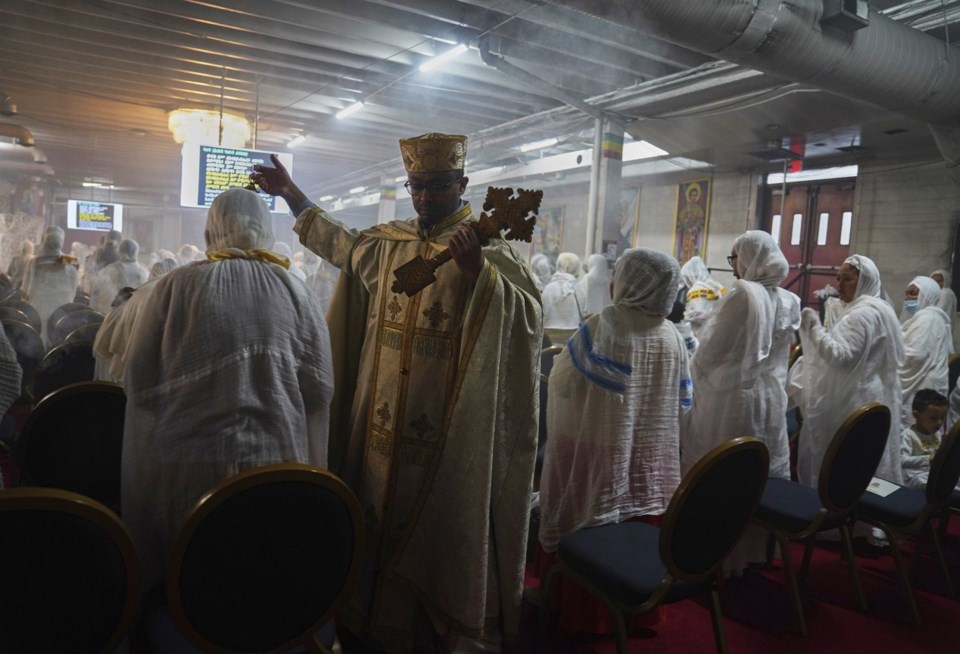WASHINGTON (AP) — In the U.S. capital, hundreds of Ethiopians dressed in traditional white shawls chant in the ancient liturgical language of one of the oldest branches of Christianity.
During hourslong worship services, the Ge’ez language reverberates throughout DSK Mariam Church. Congregants prostrate themselves in reverence to God and bow when a priest walks among them swinging a censer burning incense.
Formally known as Re’ese Adbarat Debre Selam Kidist Mariam Church, it was founded in Washington in 1987. It now has more than 1,500 registered members, and church leaders say more than 4,000 people attend services each week.
DSK Mariam is part of the Ethiopian Orthodox Tewahedo Churches — one of the oldest Christian faiths in Africa. There’s keen interest in preserving Ge’ez, and other traditions of the faith, for future generations in the bustling District of Columbia region — home to the largest Ethiopian diaspora community in the United States.
“Our tradition is full of values that are relevant for today, for the modern age. So, these kids, if they learn the tradition, the language, and also the faith — they can balance,” Abraham Habte-Sellassie, a “kesis” or priest, said ahead of a recent Lent service that started at midnight and ended at midday.
“Life here is very hectic, and it’s geared toward material profit.”
Ethiopian diaspora in the US has grown over 50 years
Many Ethiopian families have come to the U.S. over the past 50 years, having left their home country after the 1974 overthrow of the late Ethiopian Emperor Haile Selassie, who is worshipped by most members of the Rastafari faith.
Estimates range widely on the number of Ethiopians in the U.S, from more than 250,000 to unofficial estimates by diaspora leaders that it’s closer to 1 million. By far the largest Ethiopian community is in the D.C. metro area — notably the Maryland and Virginia counties close to Washington.
They contribute significantly to the area's economic well-being and cultural vitality, said Tsehaye Teferra, founder and president of a D.C.-based refugee resettlement agency, Ethiopian Community Development Council.
To reach young people and new converts, DSK Mariam also offers services in Amharic and English. Congregants can follow the prayers on large plasma TVs that hang from church columns decorated with the green, yellow and red colors of the Ethiopian flag.
“It really feels like home,” said Kannazegelila Mezgebu, a 21-year-old born in Ethiopia’s capital, Addis Ababa.
“The Ethiopian Orthodox Church has so many beautiful rituals and services. … Every day has its own meaning and a very deep one,” said Mezgebu, a senior at Morgan State University in Baltimore.
Sometimes, she said, it can be a struggle to keep up with traditions amid so many distractions in the city. But it’s worth it, she said, for the church to encourage other young Ethiopian Americans to find a fulfilling spiritual path and reconnect with their roots.
“Everything is so beautiful and so interesting to learn,” she said. “That’s what makes me really love this church.”
Symbolism is woven throughout their faith practice
“There’s so many deep, rooted meanings behind every tradition,” said Beza Bililigne, a youth ministry leader.
He pointed out examples: Congregants take off their shoes before they enter the church as a sign of respect.
The “netela,” the white scarf-like cotton cloth worn by worshippers, signifies modesty and purity and symbolizes the cloth they believe Jesus was wrapped in at birth and crucifixion, Bililigne said. The incense from the censer, he said, represents the Virgin Mary, and the coal that burns it, the divinity of Jesus.
Worship is intergenerational and incorporates the senses. During the recent service, children’s laughter mixed with the priests’ chants as deacons held an umbrella, a symbolic covering of their holy liturgy.
When bells tolled for Communion, congregants lined up to receive it, waiting their turn for a priest to break bread and place a piece into their mouths.
Some worshippers lit candles and asked for heavenly intercession to safeguard relatives back home. Ethiopia faces recurring conflict in several of its regions; millions of people are in need of food aid and health care.
“People who are here in our congregation, some have some relatives imprisoned or killed back home,” said Habte-Sellassie. “They come here and pour out their soul before the Lord so that God can bring peace to the country.”
At the end of the service, church members recorded a video of an elder chanting a liturgy passed on from his ancestors. The footage is posted on the church’s YouTube channel to preserve it for future generations in hopes they maintain the tradition.
“A lot of our traditions, a lot of our prayers are asked for us to know by memory,” Bililigne said. “As long as the person is alive, the traditions will stay alive.”
___
Associated Press religion coverage receives support through the AP’s collaboration with The Conversation US, with funding from Lilly Endowment Inc. The AP is solely responsible for this content.
Luis Andres Henao, The Associated Press

